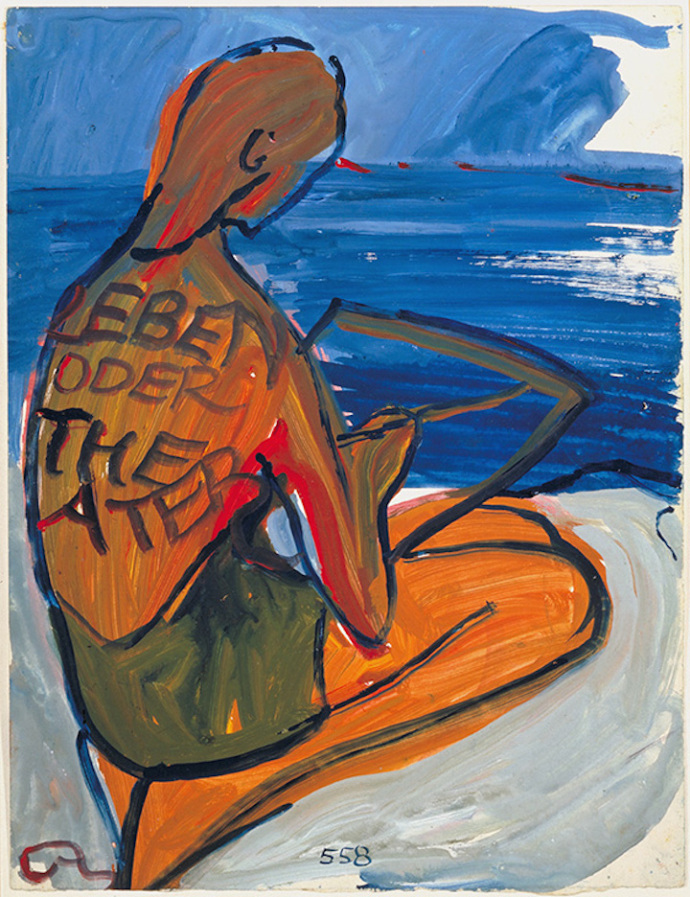New York Comics & Picture-story Symposium: Ariela Freedman on Charlotte Salomon
Charlotte Salomon was a young Jewish artist from Berlin who fled Germany after Kristallnacht, and who hid in the South of France. From 1940 to 1942, she created over thirteen hundred small gouaches and sketches that together comprised a fictionalized autobiography. Salomon rejected a number of the gouaches, leaving a narrative sequence of nearly eight hundred paintings, which she left in the keeping of a family friend when she was deported to Auschwitz, where she was murdered. The paintings combine text and image. Early in the sequence, she wrote the textual element of the story on separate, semi-transparent pieces of paper, which she taped as an overlay above the paintings. Later on, she incorporated text into the images themselves. The entire series, including the paintings that Salomon rejected, is one of the most extraordinary and understudied artworks of the century. Salomon’s work is one of a kind; it is hard to imagine how she imagined her work would be seen at all, let alone how it might be adequately reproduced. As Griselda Pollock writes, Life? Or Theatre? is “one of the twentieth century’s most challenging art works…Yet, I, for one, am not sure that I can know fully what I am looking at.” But what if we say we are looking at a comic? Leben? Oder Theater? Ein Singespeil (“Life? Or Theater? A Melodrama”), might be among the most powerful graphic narratives ever drawn and written. But it is almost entirely absent in critical discourse on comics and on graphic narrative. Part of the reason for Salomon’s absence from comics history is that Life? Or Theater? is not a comic, strictly speaking: it was not drawn to be mass-produced, and was created largely in isolation from a comics tradition. Salomon’s work provides valuable precedent for one of the most significant movements in contemporary comics, graphic memoir and testimonial. In her playful, leading, open title as question — “Life? Or Theatre?”—she introduces the tension inherent in staging autobiography. In her concurrent claim to comics and high art, Salomon anticipates the move of contemporary comics back to the gallery wall. Her foregrounding of the personal and domestic against an implicated dark history prefigures the attempts of writers like Spiegelman, Satrapi and Eisenstein to map their own stories. Life? Or Theatre? may not be exactly a comic, but it is instead something richer and stranger: a graphic narrative of an ambition and scale that has not yet been replicated, that in many ways anticipates the conventions and preoccupations of contemporary graphic memoirs. This presentation will use the semiotic vocabulary developed by comics theorists to explore Salomon’s use of word and image, to argue for Salomon’s place in the emergent comics “canon” and her importance as a multidisciplinary artist.
Ariela Freedman is an Associate Professor at the Liberal Arts College, Concordia University, Montreal. She is the author of Death, Men and Modernism (Routledge, 2003) and has a PhD in English Literature from NYU. She has published widely on literary modernism, and in the last few years has begun to publish on comics in The Journal of Modern Literature and Literature Compass and to present in forums including the “Graphic Details Symposium” (New York, 2012) and “Comics and Medicine: Navigating the Margins” (Toronto, 2012). She currently holds a SSHRC Insight Development Grant on “Charlotte Salomon, Comics and the Representation of Pain” (2013-2015) and is actively seeking cartoonists and picture-story artists whose work is influenced by Salomon. Her essays on Salomon are forthcoming in the Graphic Details anthology (2014) and in the journal Criticism (2014).

